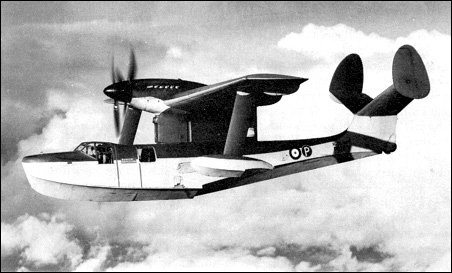|
| The first prototype flew on July 14, 1948. Did not entered production. Two built.
 | A three-view drawing (752 x 1122) |
| MODEL | 381 "Seagull" |
| CREW | 3 |
| PASSENGERS | 6 |
| ENGINE | 1 x Rolls-Royce "Griffon" 29, 1360kW |
| WEIGHTS |
| Take-off weight | 6420 kg | 14154 lb |
| Anonymous, 01.04.2021 16:33 Created to replace the Supermarine Walrus and Supermarine Sea-Otter as a catapult-launched amphibian for operation from warships. However, by the time this aircraft appeared, helicopters were already taking over the role it had been designed to perform. By the end of the 1940s helipads were replacing catapults on the decks of warships, and aircraft such as this one were becoming a thing of the past. reply | | Anonymous, 01.04.2021 16:33 Created to replace the Supermarine Walrus and Supermarine Sea-Otter as a catapult-launched amphibian for operation from warships. However, by the time this aircraft appeared, helicopters were already taking over the role it had been designed to perform. By the end of the 1940s helipads were replacing catapults on the decks of warships, and aircraft such as this one were becoming a thing of the past. reply | | Appius Claudius, 29.10.2014 22:19 Wingspsn, 16m; length, 13.4m; height, 4.84m; wing area, 40.13 sq. m. reply | | Lars Hjort Christensen, e-mail, 25.01.2008 08:41 It's the Seagull ASR mk. I reply | |
| | clive, 28.03.2007 22:31 Can you please not show E mail addresses.......or we get spammed /phished. reply | | Clive, e-mail, 28.03.2007 22:26 Sorry but you have the wrong picture in the top /index frame you are showing the biplane. Your picture used to be correct until your major overhaul.
I am working with a friend in France on a RC scale model of this final prototype version of two built the last of the Supermarine flying-boat line.
The earlier versions can be distinguished by a vertical rear edge to the central wing motor pylon and a different rear fin arrangement- the first version having only the two outer fins.
Designed as a ship born ASR aircraft it had a complex folding wing that was of variable incidence 2.5-12.5 degrees and flaps. Though troubled in its development it performed well in many ways, but it was too small and too specialised to find a role in the post war era. reply |
|
Do you have any comments?
|
| 
COMPANY
PROFILE
All the World's Rotorcraft
|











